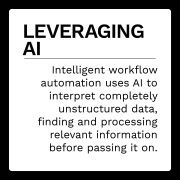Automated Invoicing Breaks Ground in the Construction Industry

![]()
While many businesses have fully digitized their consumer-facing operations, they still have a lot of work to do in transforming their business-to-business (B2B) processes. A recent report estimated that companies and their business partners exchange more than 550 billion invoices annually — a number set to quadruple by 2035. Another study found that 89% of small- to medium-sized businesses (SMBs) were still processing paper-based or PDF invoices.
![]() Implementing automation for invoice processing can help cut down on wasteful tasks such as typing invoice data, correcting typos and chasing down the status of invoices. Additionally, it can boost efficiency and productivity leading to major improvements in a company’s bottom line and reduced threat of fraud and errors.
Implementing automation for invoice processing can help cut down on wasteful tasks such as typing invoice data, correcting typos and chasing down the status of invoices. Additionally, it can boost efficiency and productivity leading to major improvements in a company’s bottom line and reduced threat of fraud and errors.
In the May edition of the AP Automation Tracker®, PYMNTS explores how businesses are using accounts payable (AP) automation to streamline invoice processing. It also explores how automating AP could pay dividends to companies in employee retention, as well as worker productivity and cost savings down the road.
Around the AP Automation Space
Cumbersome, paper-laden manual invoice processing adds two additional hours to 80% of AP professionals’ workdays, according to a recent report. The resulting burnout makes these staff members more than twice as likely to leave their organizations. The report also stated that AP departments with a high level of automation can process eight times the number of invoices per full-time equivalent employee as those with little to no automation.
![]() Some 80% of United States and United Kingdom finance leaders believe their firms’ AP operations are not capable of sustaining continued growth, according to a recent report. Many of them blame inefficiencies resulting from the use of manual processes, which they say are also leading to fraud and risk exposure. Nearly one-third of finance leaders predicted that AP hurdles could halt business growth if they continue, and 80% said finance can drive growth only when AP inefficiencies are at a minimum.
Some 80% of United States and United Kingdom finance leaders believe their firms’ AP operations are not capable of sustaining continued growth, according to a recent report. Many of them blame inefficiencies resulting from the use of manual processes, which they say are also leading to fraud and risk exposure. Nearly one-third of finance leaders predicted that AP hurdles could halt business growth if they continue, and 80% said finance can drive growth only when AP inefficiencies are at a minimum.
For more on these stories, visit the Tracker’s News and Trends section.
Bryzos on Automating Invoice Processes, Maintaining Positive Business Relationships
Invoicing is one of the most important and time-consuming tasks in the purchasing process, as vendors want to make sure they are getting paid in a timely fashion and buyers want to be sure they are getting what they paid for. Without an efficient and automated process in place, the workload can quickly become overwhelming and lead to errors and unhappy customers.
In this month’s Feature Story, Shep Hickey, founder and CEO of Bryzos, discusses how businesses can use invoice automation processes to develop and maintain positive business relationships, more efficient financial processes and preserve working capital.
 PYMNTS Intelligence: How Invoice Processing Automation Works to Streamline Workflow
PYMNTS Intelligence: How Invoice Processing Automation Works to Streamline Workflow
One of the most crucial business processes is invoicing, yet many companies lag behind on their digital transformation in this area, relying instead on inefficient and error-prone manual and paper-based methods. One report estimates that companies and their business partners exchanged more than 550 billion invoices annually, and projects that number will quadruple by 2035. Automating the processing of these invoices could cut down on staff workload and reduce errors and fraud risks while improving bottom lines.
This month’s PYMNTS Intelligence takes a close look at the technology behind invoice processing automation and how it works to streamline workflow.
About the Tracker
The “AP Automation Tracker®,” a PYMNTS and Beanworks collaboration, examines how businesses are using AP automation to streamline invoice processing. It also explores how automating AP could pay dividends to companies in employee retention, worker productivity and cost savings down the road.

